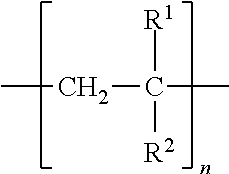Reactive polyolefin hot melt adhesive with low adhesion to uncoated aluminum tools and use thereof as a laminating hot melt
a technology of reactive polyolefin and hot melt adhesive, which is applied in the direction of adhesive types, graft polymer adhesives, manual label dispensers, etc., can solve the problems of high cost, difficult to achieve, and difficult to apply adhesive to the substrate portion
- Summary
- Abstract
- Description
- Claims
- Application Information
AI Technical Summary
Benefits of technology
Problems solved by technology
Method used
Image
Examples
examples
[0081]The roll peel strengths of the compositions presented in the following Table 1 were determined.
TABLE 1ExampleExampleExampleExampleComparisonComponent1234Example 1Silane-grafted poly-52.1853.1954.2447.6849.8α-olefinSilane-grafted poly-9.499.679.868.679.05α-olefin (10% Si) 1Poly-α-olefin wax 29.499.679.868.679.05Amorphous poly-23.7224.1824.65α-olefin 3Amorphous poly-21.6722.64α-olefin 4Tackifier8.679.05DBTL0.1UV stabilizer 50.240.240.240.250.23Catalyst 60.140.150.150.15Paraffin wax 74.742.90.994.33Optical brightener0.021 = Silane-grafted poly-α-olefin with a silane content of 10%;2 = maleic anhydride-modified polypropylene with a softening point of approximately 140° C. as well as an acid number of approximately 48 mg KOH / g;3 = amorphous poly-α-olefin with a softening point (based on the ring and ball method) in the range from 118 to 130° C., a molecular weight Mn of 7300 as well as a gas transition temperature of −28° C.;4 = amorphous poly-α-olefin with a softening point of 118...
PUM
| Property | Measurement | Unit |
|---|---|---|
| Temperature | aaaaa | aaaaa |
| Temperature | aaaaa | aaaaa |
| Temperature | aaaaa | aaaaa |
Abstract
Description
Claims
Application Information
 Login to View More
Login to View More - R&D
- Intellectual Property
- Life Sciences
- Materials
- Tech Scout
- Unparalleled Data Quality
- Higher Quality Content
- 60% Fewer Hallucinations
Browse by: Latest US Patents, China's latest patents, Technical Efficacy Thesaurus, Application Domain, Technology Topic, Popular Technical Reports.
© 2025 PatSnap. All rights reserved.Legal|Privacy policy|Modern Slavery Act Transparency Statement|Sitemap|About US| Contact US: help@patsnap.com

